August 10th, 2016


I finally left the Casino/Hotel in San Isidro with legs that were yet walking-stiff but pedaling was OK. Flat terrain led to Panama City, uneventful but not boring. From Panama City I had a couple of choices for getting to South America proper. A paved road leads east and south out the Isthmus for over a hundred miles before it ends at what’s called the Darién Gap. From there a 70 mile expanse of jungle must be crossed to reach the nearest Colombian road. To travel the Americas strictly terrestrially, one would have to cross the Darién Gap. No permanent roads exist there and to this day it’s a smuggling route (one of many) for cocaine et al headed to the U.S. It’s also territory controlled at least in part by the FARC (Armed Revolutionary Forces of Columbia), a group of guerrilla revolutionaries that have been fighting the established government in Colombia since the early 1960s. More about them below, but the upshot is that the Darién is a dangerous place. Routes through it wax and wane with ever consuming jungle growth but vehicles have been known to make it through. A Sweedish kid in his twenties tried to walk through it in 2013 and, they think, he was thought by the FARC to be a spy of some kind and they executed him. His remains were found in 2015. They say Panamanians will hire out a squad of armed guards to escort the more intrepid thru. I crossed the Darién off the list.
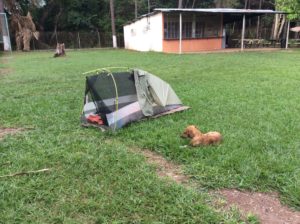
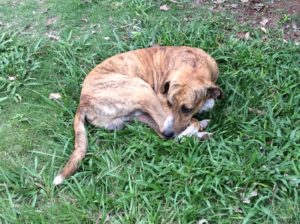
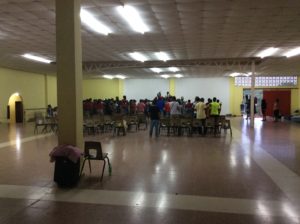
The next option was taking a sailboat from Colon (the east side of the Canal and on the Caribbean) to Colombia’s Cartegena. It takes about a week, visits tropical islands, and could have been a great respite from pedaling. I’m realizing though that time is getting short if I want to make southern Argentina before about March, 2017, the end of the Austral summer. There are several summits along the way I’d like to get to as well. That corner of the world is inhospitable enough in the summer and, as the only continental land mass in those latitudes, South America’s slim profile gets hammered by circumpolar wind. Wind is a way of life there and cycling can be really tough if it’s direction is anything but at your back. All I can say is that people do it, but I don’t want to get caught there in the winter.
Flying from Panama City to Bogotá or Medellín was the third option and the cheapest as well. According to my friend Jóse, who I met traveling north in Costa Rica, flying to Medellín cost about $100. The sailboat was more like $500 or $600 from what I found on the Internet. Both Bogotá and Medellín are well south of Cartegena, cutting off more than a third of Columbia, saving additional time. If I ever feel guilty about not cycling that part, I’ll come back with some friends and have a holiday cycling what I’m sure is a beautiful part of Columbia.
Anyway, I chose to fly and rode straight to the airport once I got to Panama City naively thinking I’d just get the $100 ticket right there. The lady at the terminal, however, quoted me $750, but I could fly that night! She said to try the Internet, so I went to a spendy airport hotel to mull things over. Surfing the net I finally found a round trip fare for $225 that left for Bogotá the next afternoon. My seat will be vacant for the return flight at the end of August. I was also able to book a hotel and, as a wonder of the modern computer world, there was a guy holding a sign up with my name on it when I got there- a first for me- for a complimentary ride to the Hotel Bogotá. $30-a-night w/ breakfast. The Panama airport hotel was $125 per night and breakfast was $16. And Colombian coffee is unbelievable. More below on that as well.
Colombia was not immune to the post WWII problems that seemed to plague Latin America. The troubles are rooted in the 1920s and 30s when, once again, communism was becoming popular in poorer countries around the world, particularly those with a wealthy, elite minority relying on labor. Colombia’s disfunctionality with the United States, though, goes back to Teddy Roosevelt and the building of the Panama Canal. Panama was then part of Colombia and treaties with the United States had been in place since the 1840s for use of land transportation across the Isthmus. Sans canal, it was still easier for ships to swap goods there than to go around Cape Horn. U.S. presence was allowed essentially in exchange for protection from piracy and revolutionaries. The U.S. readily deployed military there. When the California gold rush began in 1849 the U.S. was allowed to build and operate a railroad. This all jibed well with Monroe Doctrine.
From as early as the Conquistadores a canal was envisioned, but in the 1880s France’s Ferdinand de Lesseps, the prime developer of the Suez Canal, got investment money together and began the Panama project. The plan failed for a number of reasons but the most important were i) they attempted to dig down to sea level over the canal’s length- same as Suez, but far too ambitious here- and ii) Panama’s wet season took the lives of some 22,000 workers over 8 years due mainly to yellow fever and Malaria. The causes of each were not then proven to be from mosquitos. By 1889 the project was bankrupt and officially became a scandal. The French courts handed out several convictions of fund misappropriation that included Lesseps and even Gustave Eiffel of Eiffel Tower fame, but neither spent time in jail.
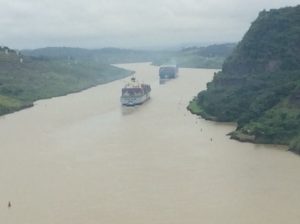
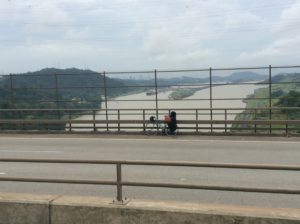
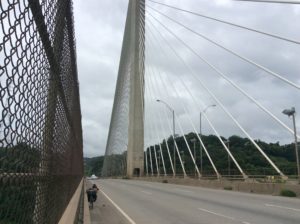
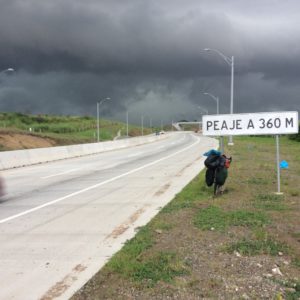
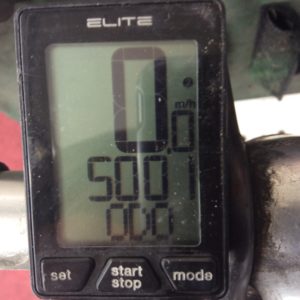
In 1894 the French tried to renew the project pretty much for enabling the sale of a viable concern. By 1903 the U.S. Senate agreed to a greatly reduced purchase price but it depended on a new Colombian treaty as to who did what with the finished product. Any potential agreements were never ratified by the Colombian government, but, very typical of Teddy Roosevelt, when the U.S. got wind of Panamanian rebels seeking independence, Roosevelt (president at the time) gave them the United States’ full support. A coup succeeded with the help of U.S. war ships preventing the Colombian army from putting down the rebellion. It amounted to “gunboat diplomacy” and was an act of war against Colombia. Naturally, the new Panamanian government cooperated well with the U.S. After-the-fact reparations were made to Colombia in 1921 with a payment of $25,000,000. Colombia in return recognized Panama’s sovereignty.
In 1904 the U.S. began work but wisely chose a design that included a system of locks that raised the ships about 50 feet to a man made lake. This design involved far less digging. Malaria and yellow fever were then understood to be from mosquitos and measures were taken to prevent the heavy losses the French encountered. There were, none-the-less, 5,600 out of 75,000 workers that died from disease and accidents. The canal was finished in 1914.
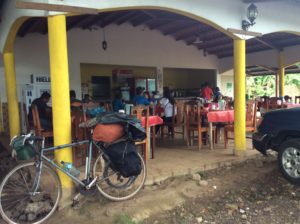
I spent two nights in Bogotá and a full day chasing bike parts (more tires and brakes) and having the bottom bracket race tightened slightly. None of it was simple but Bogotá leads Latin America (and possibly the world) in bike path travel so getting around was not bad for a city of 8 million people.
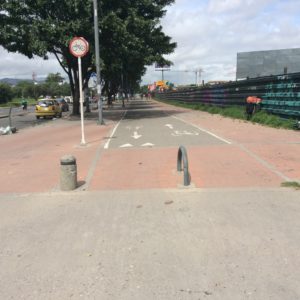
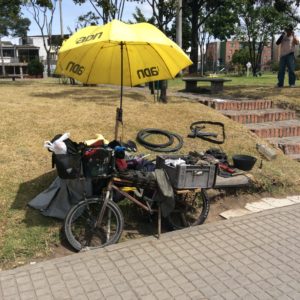
Charting a route through Colombia was done with consideration of what might be described as a low level civil war that’s been going on with more or less the original protagonists, and their descendants, since 1964. It has roots before that to 1949 when a liberal presidential candidate, Jorge Gaitán, was assassinated igniting a nine year war, The Violencia, between liberals and conservatives. Much of it was fought in rural areas and between towns with respective leanings. The conservative led government kept much of it out of the press and consequently there are many details lost to history. They think 200 to 300 thousand lives were taken and over 2 million displaced. Mixed up in the fighting was the PCC (Partida Comunista Colombiana). They were a Marxist guerrilla group that formed shortly after the Colombian government’s violent repression of a 1928 strike protesting conditions and wages for fruit workers. This made, at times, for a 3-sided war loaded with terror and atrocity.
In 1958 liberals and conservatives came to an agreement and the war boiled down to a fight against the PCC. The PCC of course supported union activities and one of the landmark events segueing into The Violencia was the Colombian government’s repression of the above mentioned fruit worker’s strike. It occurred near Santa Marta on Colombia’s Caribbean Coast. The number killed varies wildly, but they were protesting working conditions for the U.S. owned American Fruit Company which is today’s Chiquita Brands International. The company has a long history of human rights abuses, a notably poor track record for environmental practices, and has been in Federal Court in the 21st century for illegally funding Colombian paramilitaries. More on Chiquita here. One of several Colombian novels that chronicle the massacre at Santa Marta is One Hundred Years of Solitude by Nobel laureate Gabriel García Márquez.
The PCC by 1960 was splitting into factions that either pursued legal channels of resistance or those wanting to continue fighting. Out of this was born the FARC, the Revolutionary Armed Forces of Colombia, in 1964. They’ve carried on the 50 year low level civil war that I’m now navigating. They control large areas of rural Colombia for which the Colombian military effectivly doesn’t tread. A 2016 estimate of the FARC held areas is found here. On the plus side a peace agreement has been underway in Cuba for some months and was recently signed. It still needs a referendum vote. On the negative side, it’s said that many, as with the split with the PCC 50 years ago, will continue fighting. A good article on what rural Colombia is now facing is here. It’s all further complicated by paramilitary groups, closely allied to and often overlapping with Colombian military, and then of coarse the drug cartels. The cartels ally themselves to both the paramilitaries and the FARC as needed and they get all the cooperation money can buy. Being middlemen between coca growers and the cartels is one way the FARC sustain themselves, which amounts to a tax. Another way is kidnapping/ransom which was especially popular in the 1990s but waned in the 21st century as the FARC has tried to gain legitimacy as a recognized army and not a terrorist group. It still goes on today to some extent and a lone North American on a bicycle would be an easy target. (Of course, in my case they’d be disappointed to find a dearth of people willing to pay much of a ransom).
No modern history of Colombia would be complete without mention of Pablo Escobar for whom probably more Hollywood movies have been made than Wyatt Earp and Custer combined. I’ve probably bored you with enough history for now, but just google Escobar to find out more of candidate assassinations, Plata o Plomo diplomacy and the horrible world associated with drug trafficking.
The flight to Bogotá lifted me to almost 9,000 feet elevation from sea level. Not surprisingly the city has a never ending spring-like climate. Immediately leaving the city on the bike I gained a low pass to about 9,500 feet and then descended over the next 70 miles to 1000 feet spending a short lived elevation bank account. Bogotá is a thriving city that’s friendly, as big cities go, but the valley I descended into was not. A couple of restaurants wouldn’t serve me and everywhere it appeared I was viewed with suspicion. When you don’t speak the language fluently there has to be a certain amount of effort by both parties if you want to communicate. These guys were just stonewalling me. Whether it’s connected to revolutionaries, paramilitaries or just the zeitgeist I haven’t found out. I did pass two people walking down the highway, one with bandelerros over his shoulders, the other with an assault rifle. They were both in civilian clothing.
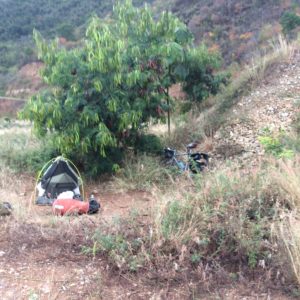
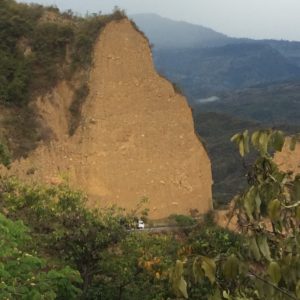
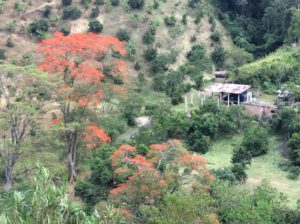
I got food where I could and began the climb to Ibagué (“music city” and home to a conservatory) where the road enters the mountains and areas where coffee is grown. Here, people were altogether more friendly. The highway climbs to a 10,000 foot pass over what’s called La Linea.
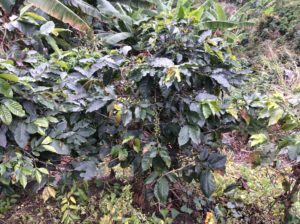
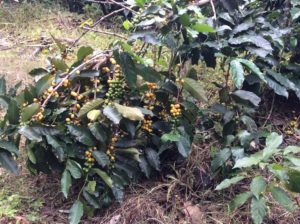
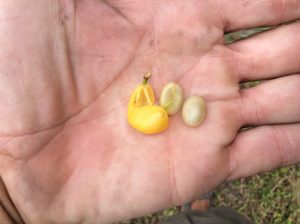
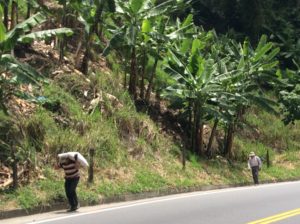
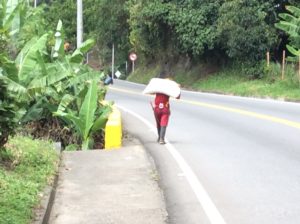
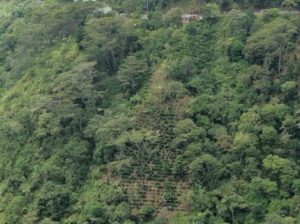
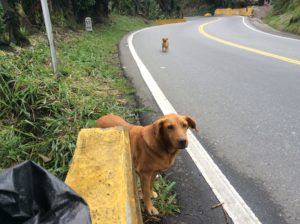
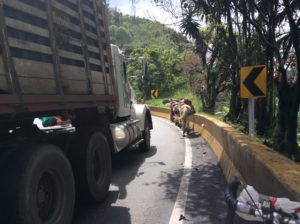
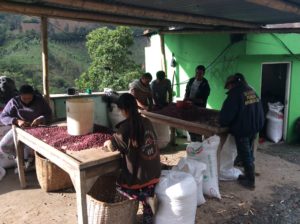
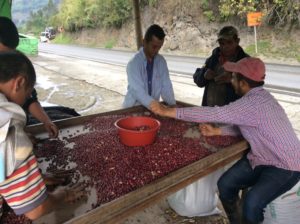
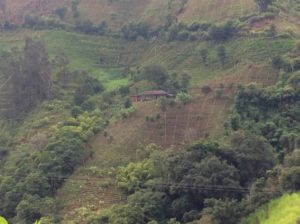
Seeing the coffee growing first hand gives one an appreciation for what goes into it. Paying a little extra for Fair Trade supported brands is the least we can do. And I don’t doubt that the demand for cocaine from a world of cocaine addicts is substantial, but the coffee addicts have to outnumber the cocaine addicts 1000-to-1. If they got more $ for coffee they could abandon coca altogether! The $billions put into the War on Drugs would more than cover it.
The climb over La Linea took two days. I got caught by near darkness trying to find a camp on the steep mountain road where few if any places to pitch a tent existed. La Linea is two-lane and has a steady stream of semi and bus traffic going 24-7 on a highway that the U.S. wouldn’t even allow heavy trucks on. It’s a main artery for transportation between the elongated valleys having the cities of Medellín and Calí on one side of the mountain, and Bogotá on the other. They have, however, been working on a new highway that’s nothing short of an engineering marvel. It’s been many years in the works, and will be many more, but there are a number of tunnels, some accessible from the present highway. With permission from a couple of workers, who really could have cared less, I slept in one. Later, some cyclists I met in Calí (Jonathon and Gustavo, pictured below), noted wryly that the tunnel finally got used by someone.
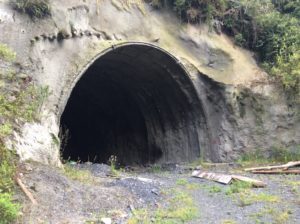
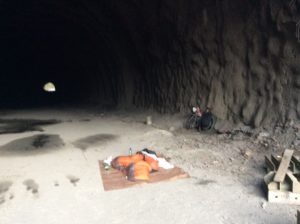
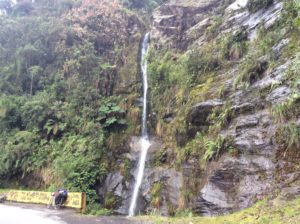
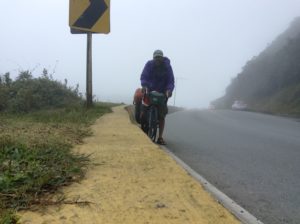
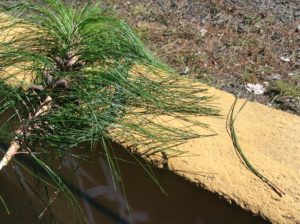
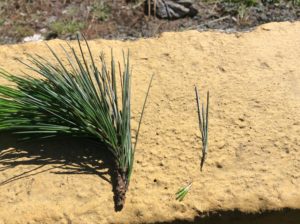
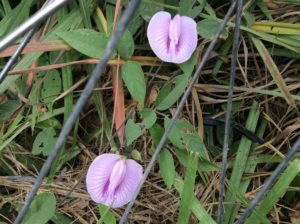
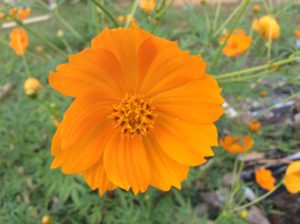
The 6000 foot descent down the other side was steep enough to be slow and scary as well as putting considerable wear on the new brakes. Flatter terrain led 150 or so miles to Calí where I am now staying three days at the Ruta Sur Hostel. Jonathan and Gustovo led me here and it has been a great place to rest and work on the blog.
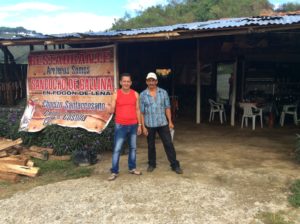
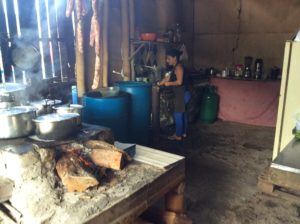
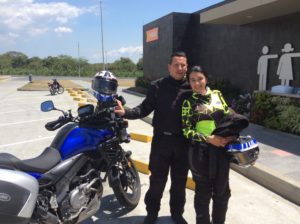
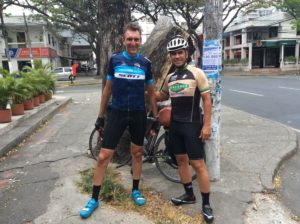
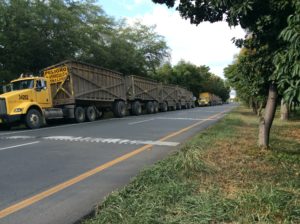
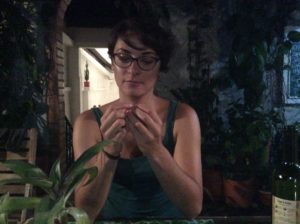
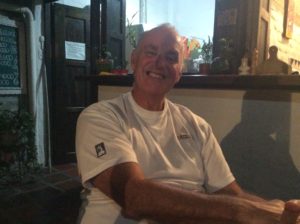
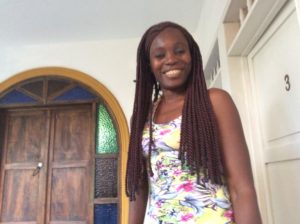
Today I head for Ecuador and may be to the border in a few days.